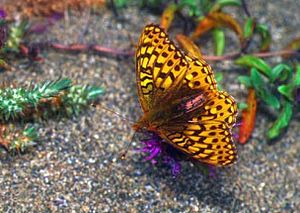Myrtle's silverspot facts for kids
Quick facts for kids Speyeria zerene myrtleae |
|
|---|---|
 |
|
| Conservation status | |
| Scientific classification |
|
| Kingdom: | Animalia |
| Phylum: | Arthropoda |
| Class: | Insecta |
| Order: | Lepidoptera |
| Family: | Nymphalidae |
| Genus: | Speyeria |
| Species: |
S. zerene
|
| Subspecies: |
S. z. myrtleae
|
| Trinomial name | |
| Speyeria zerene myrtleae Dos Passos & Grey, 1945
|
|
The Myrtle's silverspot (Speyeria zerene myrtleae) is a beautiful, medium-sized butterfly. It belongs to the brush-footed butterfly family, called Nymphalidae. This butterfly is a special type, or subspecies, of the zerene fritillary. Sadly, it is an endangered species, which means it is at risk of disappearing forever.
This butterfly lives only in California. You can find it in just a few places north of the San Francisco Bay Area. Two of these spots are in the Point Reyes National Seashore. The Myrtle's silverspot has a wingspan of about 5.6 centimeters (2.2 inches). Its top wings are golden brown with many black spots and lines. The undersides of its wings are brown, orange, and tan with black lines and shiny silver and black spots.
Contents
Life Cycle of the Myrtle's Silverspot
The female Myrtle's silverspot lays her eggs one at a time. She places them on the dried leaves of violet plants. The only plant known for the caterpillars to eat is the western dog violet.
When the eggs hatch, tiny caterpillars come out. They crawl a short way and then spin small silk pads. They spend the winter resting on these pads. In the spring, the caterpillars wake up and immediately look for violet plants to eat.
After about 7 to 10 weeks, each caterpillar changes into a pupa. It makes a special chamber from leaves, gluing them together with silk. About two weeks later, the adult butterfly emerges. These adult butterflies can live for about three weeks. They fly from late June to early September.
Adult butterflies drink nectar from many different flowers. These include gumplants, yellow sand verbena, coyote mints (especially M. undulata), bull thistle, and seaside daisy.
Where Myrtle's Silverspot Lives
Myrtle's silverspot butterflies live in sand dunes and coastal grasslands. They used to live in dunes and bluffs from San Mateo County up to the Russian River in Sonoma County. However, many populations south of the Golden Gate have disappeared because of cities growing.
Today, four groups of these butterflies live in western Marin and southwestern Sonoma counties. This includes areas like Point Reyes. You can usually find adult butterflies in places that are protected from strong winds. They live below 250 meters (820 feet) in elevation. They also stay within 5 kilometers (3 miles) of the coast.
Protecting Myrtle's Silverspot
The Myrtle's silverspot butterfly was officially listed as an endangered species in 1992. One of the biggest reasons it is endangered is habitat loss. When homes and businesses are built, the butterfly's natural home is destroyed. This has made them disappear from some areas. It also threatens the groups that are left.
It is very important to protect the violet plants for the caterpillars and the nectar flowers for the adults. Changes in natural fire patterns can also hurt the plants the butterflies need. New plants that are not native to the area, called exotic plants, can also take over. This reduces the food available for the butterflies.
Sometimes, too much or too little grazing by animals can also make the plant communities bad for the butterflies. To help them, people are working to remove invasive plants like iceplant (Mesembryanthemum spp.). They are also trying to find the right ways to manage grazing and burning in grasslands.
These butterflies are also very sensitive to pesticides. Pesticides are chemicals used to kill insects, but they can harm these rare butterflies too.
Images for kids



